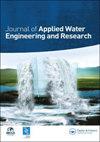用响应面法设计和优化顺序和混合高级氧化工艺系统
IF 1.6
Q4 WATER RESOURCES
Journal of Applied Water Engineering and Research
Pub Date : 2022-10-14
DOI:10.1080/23249676.2022.2125092
引用次数: 1
摘要
在炼油厂污水处理的不同方法中,高级氧化工艺(AOPs)(如电芬顿)和纳米零价铁(nZVI)颗粒的应用最近引起了人们的极大兴趣。与这些方法相关的约束启发了顺序混合系统的设计,通过该系统,与传统系统相比,获得了更高的处理效率和更少的能耗。混合系统由按顺序工作的电Fenton和nZVI浆料系统组成。两个子系统首先使用响应面方法(RSM)进行优化,然后相应地设计混合系统。混合系统仅用47.5分钟就达到了94.06%的COD去除率 min(COD初始值 = 500 mg/L,[nZVI] = 0.9 g/L和H2O2/Fe2+ = 3.6) min,以获得类似的效率。GC–MS分析也支持了混合系统相对于传统系统的优势。本文章由计算机程序翻译,如有差异,请以英文原文为准。
Design and optimization of a sequential and hybrid advanced oxidation process system using response surface methodology
Of different approaches for refinery effluent treatment, the application of Advanced Oxidation Processes (AOPs) (e.g. electro-Fenton) and nano Zero-Valent Iron (nZVI) particles have been of great interest lately. Associated constraints with these methods inspired the design of a sequential hybrid system by which higher treatment efficiency and less energy consumption were acquired compared to a conventional system. The hybrid system consisted of an electro-Fenton and an nZVI slurry system working in sequence. Both sub-systems were first optimized using the Response Surface Methodology (RSM), and the hybrid system was then designed accordingly. 94.06% of COD removal was achieved by the hybrid system in only 47.5 min at its optimum condition (CODinitial = 500 mg/L, [nZVI] = 0.9 g/L, and H2O2/Fe2+ = 3.6). Whereas it took more than 75 min for the single electro-Fenton system to acquire similar efficiency. GC–MS analysis also supported the superiority of the hybrid system over the conventional one.
求助全文
通过发布文献求助,成功后即可免费获取论文全文。
去求助
来源期刊

Journal of Applied Water Engineering and Research
WATER RESOURCES-
CiteScore
2.90
自引率
16.70%
发文量
31
期刊介绍:
JAWER’s paradigm-changing (online only) articles provide directly applicable solutions to water engineering problems within the whole hydrosphere (rivers, lakes groundwater, estuaries, coastal and marine waters) covering areas such as: integrated water resources management and catchment hydraulics hydraulic machinery and structures hydraulics applied to water supply, treatment and drainage systems (including outfalls) water quality, security and governance in an engineering context environmental monitoring maritime hydraulics ecohydraulics flood risk modelling and management water related hazards desalination and re-use.
 求助内容:
求助内容: 应助结果提醒方式:
应助结果提醒方式:


